
The Javan rhinoceros, Javan rhino, Sunda rhinoceros or lesser one-horned rhinoceros is a critically endangered member of the genus Rhinoceros, of the rhinoceros family, Rhinocerotidae, and one of the five remaining extant rhinoceros species across South Asia and Africa. The Javan rhinoceros is one of the smallest rhinoceros species, along with the Sumatran, or "hairy", rhinoceros. They are superficially similar to Indian rhinos, as they have plate-like, "armored" protective skin folds, but are slightly smaller in size, at just 3.1–3.2 m (10–10 ft) long and 1.4–1.7 m (4.6–5.6 ft) tall, on average. The heaviest specimens weigh around 2,300 kg/2.3 tonnes, similar to a black rhinoceros. However, unlike the long and potentially lethal horns of the black or white rhinoceroses of Africa, the Javan species' single, somewhat blunted horn is usually shorter than 25 cm (9.8 in).

The Siamese crocodile is a medium-sized freshwater crocodile native to Indonesia, Brunei, East Malaysia, Laos, Cambodia, Myanmar, Thailand and Vietnam. The species is critically endangered and already extirpated from many regions. Its other common names include Siamese freshwater crocodile, Singapore small-grain, and soft-belly.

The large-spotted civet is a viverrid native to Southeast Asia that is listed as Endangered on the IUCN Red List.
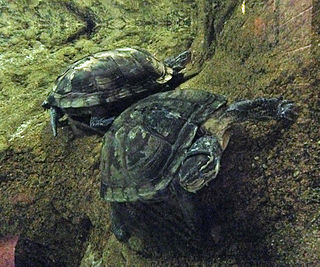
The Vietnamese pond turtle or Annam leaf turtle is a species of turtle in the family Geoemydidae.

The Yangtze giant softshell turtle, also known commonly as the Red River giant softshell turtle, the Shanghai softshell turtle, the speckled softshell turtle, and Swinhoe's softshell turtle, is an extremely rare species of turtle in the family Trionychidae. It may be the largest living freshwater turtle in the world. The species is native to eastern and southern China and northern Vietnam. With a known population of only two or three individuals, and with the last known females dying out, this species is considered functionally extinct.
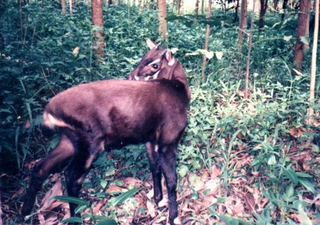
The wildlife of Vietnam is rich in flora and fauna as reflected by its unique biodiversity. Saola, rare and antelope-like animal categorized under the bovine subfamily, was found in 1992 in Vũ Quang National Park. In the 1990s, three other muntjac species, the deer-like Truong Son muntjac, giant muntjac and Pu Hoat muntjac, were also discovered. Conservation protection and scientific studies of the ecology of Vietnam, particularly in the protected forest areas, have been given priority attention by the Government of Vietnam. Laws were enacted to set up Xuân Thủy Wetland National Park, four UNESCO Biosphere Reserves, and Hạ Long Bay and Phong Nha-Kẻ Bàng National Parks; the last two are also designated as UNESCO World Heritage Sites.
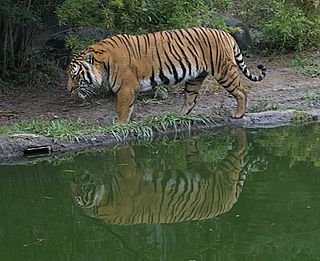
The wildlife of Laos encompasses the animals and plants found in the Lao People's Democratic Republic, a landlocked country in southeastern Asia. Part of the country is mountainous and much of it is still clad in tropical broadleaf forest. It has a great variety of animal and plant species.

Rafetus is a genus of highly endangered softshell turtles in the family Trionychidae. It is a genus of large turtles which are found in freshwater habitats in Eurasia.
Feihyla palpebralis is a species of frog in the family Rhacophoridae, sometimes known as the Vietnamese bubble-nest frog or the white-cheeked small treefrog. In addition to its type locality, Langbian Plateau in southeastern Vietnam, it may have been found in southern China and northern Vietnam south to Tam Dao, though some of these may have been misidentifications, and it is expected to be found in the intervening Laos and Vietnam.

The Black-breasted leaf turtle, also commonly called the Vietnamese leaf turtle or the black-breasted hill turtle, a species of turtle. The species is listed as one of the smallest turtle species in the world. The species is endemic to Southeast Asia and is listed as endangered as of July 16, 2018.
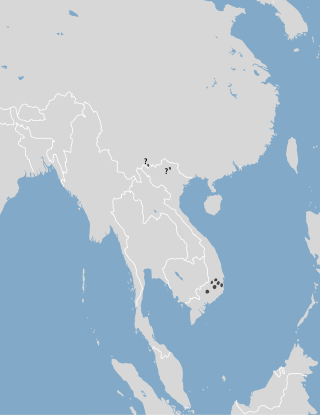
The small-toothed mole is a species of mammal in the family Talpidae. It is found in Di Linh, in southern Vietnam, and Rakho near the border of Vietnam and China, and in southern Yunnan, China, near the Vietnamese border. It is likely that it has a broader distribution, especially in places between the currently known locations.
Aphaostracon xynoelictum, the Fenney Spring hydrobe, is a species of freshwater snails in the family Hydrobiidae.
Exquisitiropa is a monotypic genus of small land snails in the family Charopidae. The sole species is Exquisitiropa agnewi, also known as silky snail or silky pinwheel snail. It is endemic to Tasmania.

The southern Vietnamese box turtle is endemic to the southern mountainous regions of Vietnam, and possibly also occurring in extreme eastern Cambodia and southern Laos. It is known only from Khanh Hoa and southern Phu Yen provinces, but may also occur in eastern Dak Lak and northern Ninh Thuan provinces.
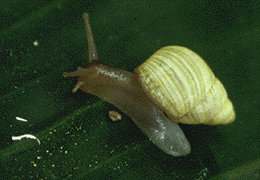
Partula is a genus of air-breathing tropical land snails, terrestrial pulmonate gastropod mollusks in the family Partulidae.
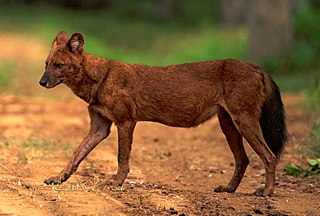
An endangered species is a species that is very likely to become extinct in the near future, either worldwide or in a particular political jurisdiction. Endangered species may be at risk due to factors such as habitat loss, poaching, invasive species, and climate change. The International Union for Conservation of Nature (IUCN) Red List lists the global conservation status of many species, and various other agencies assess the status of species within particular areas. Many nations have laws that protect conservation-reliant species which, for example, forbid hunting, restrict land development, or create protected areas. Some endangered species are the target of extensive conservation efforts such as captive breeding and habitat restoration.

Placostylus ambagiosus is a species of flax snail, a large air-breathing land snail, a terrestrial pulmonate gastropod mollusc in the family Bothriembryontidae.

The World's 25 Most Endangered Primates is a list of highly endangered primate species selected and published by the International Union for Conservation of Nature (IUCN) Species Survival Commission (SSC) Primate Specialist Group (PSG), the International Primatological Society (IPS), Global Wildlife Conservation (GWC), and Bristol Zoological Society (BZS). The IUCN/SSC PSG worked with Conservation International (CI) to start the list in 2000, but in 2002, during the 19th Congress of the International Primatological Society, primatologists reviewed and debated the list, resulting in the 2002–2004 revision and the endorsement of the IPS. The publication was a joint project between the three conservation organizations until the 2012–2014 list when BZS was added as a publisher. The 2018–2020 list was the first time Conservation International was not among the publishers, replaced instead by GWC. The list has been revised every two years following the biannual Congress of the IPS. Starting with the 2004–2006 report, the title changed to "Primates in Peril: The World's 25 Most Endangered Primates". That same year, the list began to provide information about each species, including their conservation status and the threats they face in the wild. The species text is written in collaboration with experts from the field, with 60 people contributing to the 2006–2008 report and 85 people contributing to the 2008–2010 report. The 2004–2006 and 2006–2008 reports were published in the IUCN/SSC PSG journal Primate Conservation,, since then they have been published as independent publications.















